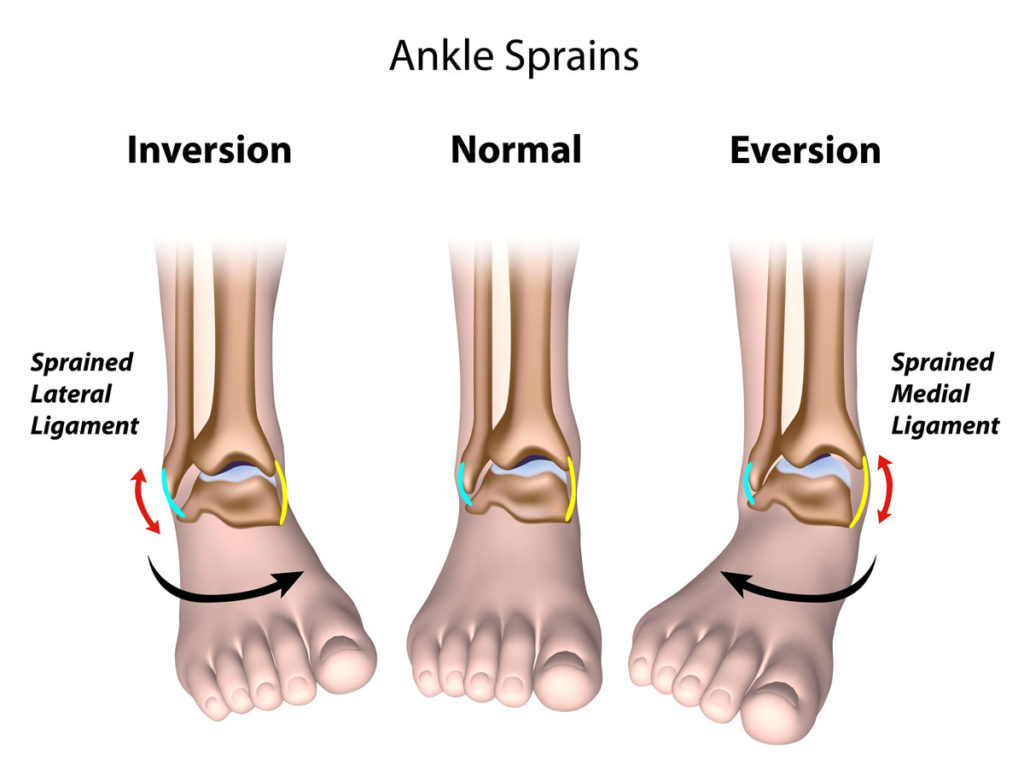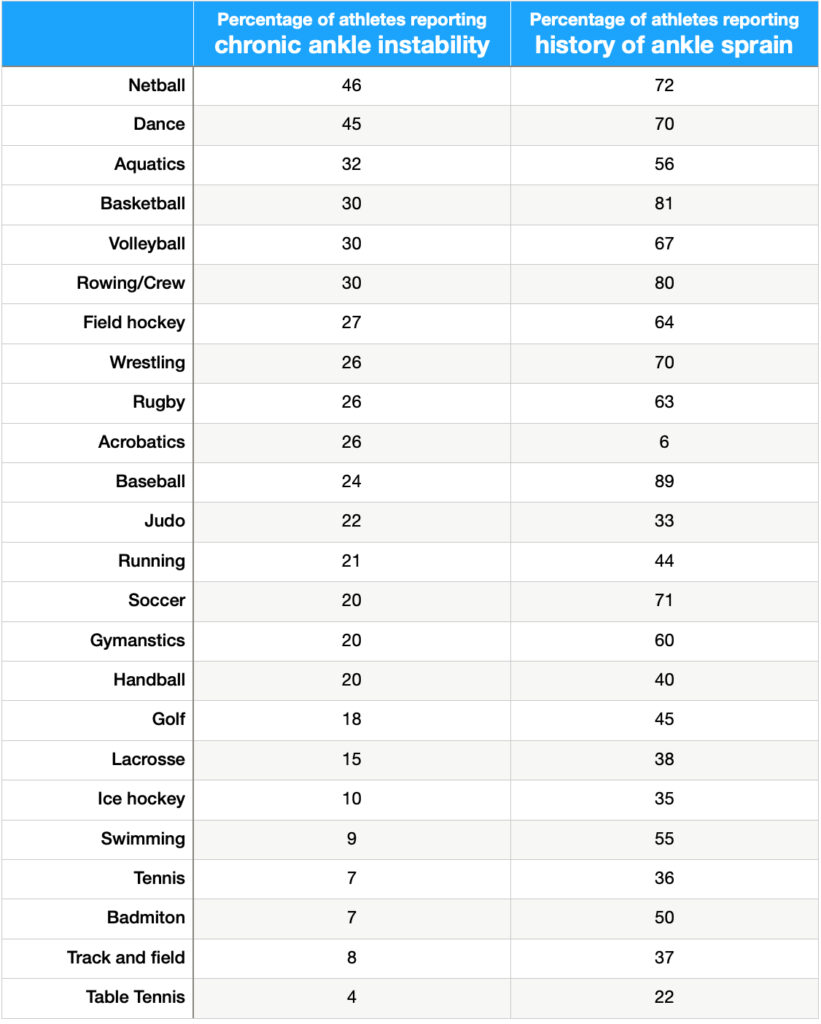
While data points towards “field sports” such as football, soccer and volleyball as high risk sports, ankle sprains can occur with participation in other athletic events including dance, judo, jiu jitsu and gymnastics.
The table below shows percentages of athletes within a specific sport that have chronic ankle instability and the percentage of athletes reporting a history of ankle pain.

Gender differences exist: females, are twice as likely to experience an ankle sprain. While the literature is unclear as to specific causes, several biomechanical, hormonal and musculoskeletal theories have been proposed, but are generally inconclusive.

It is interesting to note that very few people seek care from emergency care. This has been postulated to be due to most individuals being able to “get by” once the swelling and acute pain have subsided. Swelling often takes a week or 2 to resolve. A typical treatment approach for early intervention is the RICE method. Rest, Ice, compression & elevation. While this may help considerably in the short term, with most people can go about their daily routine, a large percentage (between 20-46%) will experience a subsequent injury within a year. Surveys demonstrate that 73% of athletes have sustained two sprains of the same ankle.
There have been algorithms that help medical professionals determine whether or not an athlete should have diagnostic imaging (x-rays) in an emergency situation. You can find that article HERE.
Reinjury rates vary between 20% (low) and 46% (high), depending on the level of activity, sport participation and other factors. Indeed, a previous ankle sprain is the biggest predictor for experiencing a subsequent sprain. Once injured, there is a 3.5x greater risk of experiencing a second ankle sprain.
Chronic ankle instability develops in about 70% of athletes after the first ankle sprain. This condition is described as a significant ankle sprain, feelings of instability or more than 2 episodes of giving way in the past 6 months.
Post-traumatic osteoarthritis may develop in the affected ankle as well. This is characterized by early degeneration of joint cartilage due to the high velocity trauma (acute), in addition to altered joint movement after the injury (chronic, repetitive). Because ankle sprains occur most often in youth and adolescent athletes, this may cause painful walking and participation in sports later on in life. Of all post-traumatic osteoarthritis cases of the ankle, 80% could be attributed to an ankle sprain earlier in life.
The good news is that there is plenty of research demonstrating that specific interventions can significantly reduce the risk of subsequent injury by 81%! Professional soccer teams that adopted the FIFA 11+ protocol were able to reduce lower extremity injury by 30%. With a 46% reinjury rate, athletes should be JUMPING at that opportunity. Given the post-injury complications, engaging in a quality program is well worth the investment if it means pursuing your passion.
Absolutely! I have helped hundreds of performing artists at Royal Caribbean and Celebrity cruises with many types of injuries. And performing artists are known for ankle injuries! Early intervention, coupled with confidence building and strength training exercises have helped high level athletes continue on with their career.
The most important thing is that a proper history, evaluation and program tailored to your specific goals are completed. Few physical therapists understand the commitment athletes make- sacrificing hanging out with friends to make practice. Sacrificing vacations to compete. I’ve been there and I’ve done that, now I want to help the next generation of athletes stay active and healthy.
A quick phone call will help determine what the best course of action for you is. We can set that up by having you call the number below.
In the athletic population, for every 1000 athlete exposures (training session, game, performance), there is 1 athlete that will experience a lateral ankle injury. Medial and high ankle sprains are much less common. Of all ankle sprains, 3/4 are of the lateral ankle and 1/4 are of the medial or high ankle.

While data points towards “field sports” such as football, soccer and volleyball as high risk sports, ankle sprains can occur with participation in other athletic events including dance, judo, jiu jitsu and gymnastics.
The table below shows percentages of athletes within a specific sport that have chronic ankle instability and the percentage of athletes reporting a history of ankle pain.

Gender differences exist: females, are twice as likely to experience an ankle sprain. While the literature is unclear as to specific causes, several biomechanical, hormonal and musculoskeletal theories have been proposed, but are generally inconclusive.

It is interesting to note that very few people seek care from emergency care. This has been postulated to be due to most individuals being able to “get by” once the swelling and acute pain have subsided. Swelling often takes a week or 2 to resolve. A typical treatment approach for early intervention is the RICE method. Rest, Ice, compression & elevation. While this may help considerably in the short term, with most people can go about their daily routine, a large percentage (between 20-46%) will experience a subsequent injury within a year. Surveys demonstrate that 73% of athletes have sustained two sprains of the same ankle.
There have been algorithms that help medical professionals determine whether or not an athlete should have diagnostic imaging (x-rays) in an emergency situation. You can find that article HERE.
Reinjury rates vary between 20% (low) and 46% (high), depending on the level of activity, sport participation and other factors. Indeed, a previous ankle sprain is the biggest predictor for experiencing a subsequent sprain. Once injured, there is a 3.5x greater risk of experiencing a second ankle sprain.
Chronic ankle instability develops in about 70% of athletes after the first ankle sprain. This condition is described as a significant ankle sprain, feelings of instability or more than 2 episodes of giving way in the past 6 months.
Post-traumatic osteoarthritis may develop in the affected ankle as well. This is characterized by early degeneration of joint cartilage due to the high velocity trauma (acute), in addition to altered joint movement after the injury (chronic, repetitive). Because ankle sprains occur most often in youth and adolescent athletes, this may cause painful walking and participation in sports later on in life. Of all post-traumatic osteoarthritis cases of the ankle, 80% could be attributed to an ankle sprain earlier in life.
The good news is that there is plenty of research demonstrating that specific interventions can significantly reduce the risk of subsequent injury by 81%! Professional soccer teams that adopted the FIFA 11+ protocol were able to reduce lower extremity injury by 30%. With a 46% reinjury rate, athletes should be JUMPING at that opportunity. Given the post-injury complications, engaging in a quality program is well worth the investment if it means pursuing your passion.
Absolutely! I have helped hundreds of performing artists at Royal Caribbean and Celebrity cruises with many types of injuries. And performing artists are known for ankle injuries! Early intervention, coupled with confidence building and strength training exercises have helped high level athletes continue on with their career.
The most important thing is that a proper history, evaluation and program tailored to your specific goals are completed. Few physical therapists understand the commitment athletes make- sacrificing hanging out with friends to make practice. Sacrificing vacations to compete. I’ve been there and I’ve done that, now I want to help the next generation of athletes stay active and healthy.
A quick phone call will help determine what the best course of action for you is. We can set that up by having you call the number below.

Lateral ankle sprains are often a result of an athlete planting and “rolling over” the outside of the foot. This results in micro or macroscopic tearing of the lateral ligament complex, often affecting the ankle joint cartilage, and possible bone related injury at high forces.
In the athletic population, for every 1000 athlete exposures (training session, game, performance), there is 1 athlete that will experience a lateral ankle injury. Medial and high ankle sprains are much less common. Of all ankle sprains, 3/4 are of the lateral ankle and 1/4 are of the medial or high ankle.

While data points towards “field sports” such as football, soccer and volleyball as high risk sports, ankle sprains can occur with participation in other athletic events including dance, judo, jiu jitsu and gymnastics.
The table below shows percentages of athletes within a specific sport that have chronic ankle instability and the percentage of athletes reporting a history of ankle pain.

Gender differences exist: females, are twice as likely to experience an ankle sprain. While the literature is unclear as to specific causes, several biomechanical, hormonal and musculoskeletal theories have been proposed, but are generally inconclusive.

It is interesting to note that very few people seek care from emergency care. This has been postulated to be due to most individuals being able to “get by” once the swelling and acute pain have subsided. Swelling often takes a week or 2 to resolve. A typical treatment approach for early intervention is the RICE method. Rest, Ice, compression & elevation. While this may help considerably in the short term, with most people can go about their daily routine, a large percentage (between 20-46%) will experience a subsequent injury within a year. Surveys demonstrate that 73% of athletes have sustained two sprains of the same ankle.
There have been algorithms that help medical professionals determine whether or not an athlete should have diagnostic imaging (x-rays) in an emergency situation. You can find that article HERE.
Reinjury rates vary between 20% (low) and 46% (high), depending on the level of activity, sport participation and other factors. Indeed, a previous ankle sprain is the biggest predictor for experiencing a subsequent sprain. Once injured, there is a 3.5x greater risk of experiencing a second ankle sprain.
Chronic ankle instability develops in about 70% of athletes after the first ankle sprain. This condition is described as a significant ankle sprain, feelings of instability or more than 2 episodes of giving way in the past 6 months.
Post-traumatic osteoarthritis may develop in the affected ankle as well. This is characterized by early degeneration of joint cartilage due to the high velocity trauma (acute), in addition to altered joint movement after the injury (chronic, repetitive). Because ankle sprains occur most often in youth and adolescent athletes, this may cause painful walking and participation in sports later on in life. Of all post-traumatic osteoarthritis cases of the ankle, 80% could be attributed to an ankle sprain earlier in life.
The good news is that there is plenty of research demonstrating that specific interventions can significantly reduce the risk of subsequent injury by 81%! Professional soccer teams that adopted the FIFA 11+ protocol were able to reduce lower extremity injury by 30%. With a 46% reinjury rate, athletes should be JUMPING at that opportunity. Given the post-injury complications, engaging in a quality program is well worth the investment if it means pursuing your passion.
Absolutely! I have helped hundreds of performing artists at Royal Caribbean and Celebrity cruises with many types of injuries. And performing artists are known for ankle injuries! Early intervention, coupled with confidence building and strength training exercises have helped high level athletes continue on with their career.
The most important thing is that a proper history, evaluation and program tailored to your specific goals are completed. Few physical therapists understand the commitment athletes make- sacrificing hanging out with friends to make practice. Sacrificing vacations to compete. I’ve been there and I’ve done that, now I want to help the next generation of athletes stay active and healthy.
A quick phone call will help determine what the best course of action for you is. We can set that up by having you call the number below.